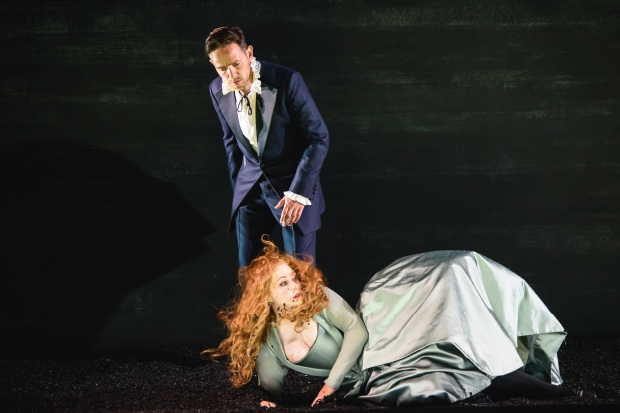Caius Gabriel Cibber’s statues of ‘Melancholy’ and ‘Raving Madness’, their eyes staring blindly into the void, petrified in torment, once posed on top of the gate to Bedlam. In 1739, when Handel’s dramatic oratorio Saul was first performed, you could pay a modest fee to pass beneath them and gawk at the living spectacles within, victims of ‘arbitrary passions’ including pride, lust and envy.
In Barrie Kosky’s Glyndebourne staging of Saul, Cibber’s archetypes are animated and given voice by Christopher Purves as the king driven mad by ‘Envy! Eldest born of Hell!’ Saul was the second of Handel’s great studies of madness. But where Orlando (1733) proposes a cure, restoring the hero to his senses after a sequence of florid scenes of delirium, Saul ends in disgrace, defeat and death. In Acts 1 and 2, Kosky’s Israelites jabber and point like Bedlam’s Georgian tourists. They’re half-crazed by the opulent spoils (Dutch-Flemish floral arrangements, stuffed swans and peacocks, the smooth flanks of slaughtered deer) of their victory over the Philistines and the grotesque totem of the head of Goliath (designs by Katrin Lea Tag). Powdered, painted and periwigged, clad in silks of primrose, kingfisher, duck-egg blue, salmon pink and olive, they jump and scamper and gasp and squeal.
Their High Priest (Benjamin Hulett) is a monstrous jester in a ruff. The physicality of Kosky’s movement direction and Otto Pichler’s punk-baroque choreography of the six dancers is startling, especially in contrast with the stillness of Saul’s champion and nemesis, David (Iestyn Davies), whose coolness and poise triggers love in the hearts of Michal (Sophie Bevan) and Jonathan (Paul Appleby), and hatred in the hearts of Merab (Lucy Crowe) and Saul. Sublimely sung by Davies, David remains an ambiguous, even dangerous figure in Kosky’s reading, his motives mysterious, his sexuality apparently as fluid as his voice. Throughout, Joachim Klein’s lighting design plays skilfully with ideas of artifice and nature, now flat and brilliant, now soft and dewy — contrasts mirrored in the voices, gestures and singing styles of Crowe and Hulett, and Bevan and Appleby.
There is an abundance of spectacle in the production, even an excess. In the Act 2 Symphony, a miniature organ concerto, organist James McVinnie plays on stage on a revolve that rises up from a battlefield lit by votive candles. On the first night, even the candles got a round of applause. But the gaudy grotesquerie dissolves when we are alone with Purves’s Saul: stripped of his power, his clothes and his wig; muttering desperately to himself (‘I’m the king! I’m the king! I’m the king! I’m the king!’); running around the bare earth; growling and howling his grand recitative (‘Wretch that I am, of my own ruin author!’); birthing John Graham-Hall’s Witch of Endor and suckling noisily and greedily at her breast.
Here is Melancholy and Raving Madness, possession and a prophecy of defeat. It’s a fearless performance from Purves, one that cracks the voice and wracks the heart, and is matched in its bravery by the young chorus. So why is the orchestral performance so pallid? Under Ivor Bolton’s direction, the strings of the Orchestra of the Age of Enlightenment play politely, still in oratorio mode, teetotalers at a bacchanalia. Obbligato solos for flute (Lisa Beznosiuk), harp (Frances Kelly) and carillon (described by one member of Handel’s original audience as sounding like ‘squirrels in a cage’) spool out seductively, while the sackbuts and kettledrums work their dusty magic in the ‘Dead March’. But too much of the playing is weak, dry and unambitious in its response to what happens on stage.
For Handelian string playing of real vitality, rhythmic verve and dramatic engagement at point-blank range, head to the tiny cloisters in the gardens of Iford Manor where harpsichordist Christopher Bucknall directs an orchestra of 11 players in a vivacious account of Agrippina (1709). Here is articulation so smart that you could cut your finger on it, a rich tonal range and an abundance of exuberantly improvised decorations from leader Bojan Cicic. Designed by Kimm Kovac, Bruno Ravella’s production of Handel’s only Venetian opera is a thrift-shop fantasy of the 1980s, half Jackie Collins novel, half John Hughes movie. There are perms, shoulder-pads, personal stereos, leotards, gold lamé and leg-warmers. There’s even a hot-tub in the font.
Where Saul offers a moral lesson, Agrippina offers a farce of thwarted sexual desires and attempted assassinations. Alinka Kozari’s chiselled cheekbones and chiselled coloratura combine to arresting effect in the shameless, scheming title role, while Ciara Hendrick dazzles as her son, the brattish Nerone. As nubile Poppea, Louise Kemeny deftly juggles the attentions of Nerone and Andrew Slater’s lust-befuddled Claudio, saving her sweetest singing for the gorgeous Act 3 duet with Rupert Enticknap’s smitten Ottone. Gareth Brynmor John, Tom Verney and Bradley Travis deliver the supporting roles of Pallante, Narciso and Lesbus with seedy flair.






Comments